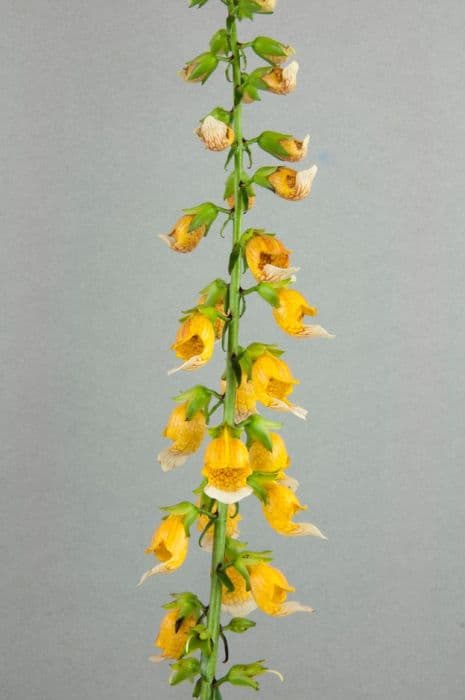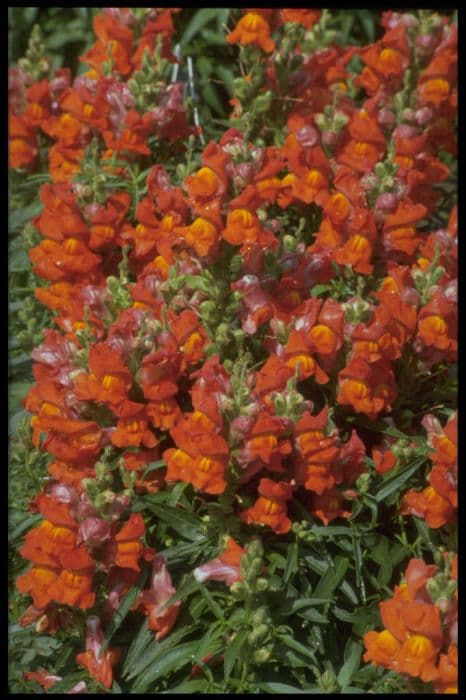Grecian Foxglove Digitalis laevigata

ABOUT
Digitalis laevigata, commonly known as the smooth foxglove, is a perennial plant renowned for its striking and elegant appearance. It features a rosette of oblong lance-shaped leaves that are green in color, with a glossy texture that gives it the characteristic 'smooth' aspect in its common name. The foliage forms a base from which emerges a tall, slender spike adorned with tubular flowers. These blooms are typically a warm shade of yellow with a paler throat, intricately spotted and speckled within, giving them a distinguished look. Each individual flower hangs downward, resembling the extended fingers of a glove, a quality that contributed to the 'foxglove' portion of its name. The flowers are neatly arranged around the spike and bloom in succession from the bottom upwards. The combination of the length of the spike and the bell-like flowers creates a stately and captivating presence in a garden setting. The plant’s flowers are known to be a magnet for certain pollinators, adding an ecological value to its ornamental charm.
About this plant
 Names
NamesFamily
Plantaginaceae
Synonyms
Grecian Foxglove, Smooth Foxglove
Common names
Digitalis ambigua, Digitalis laevigata var. ambigua, Digitalis lutea subsp. laevigata.
 Toxicity
ToxicityTo humans
Digitalis laevigata, commonly known as Grecian foxglove, is a plant that is toxic to humans. The plant contains cardiac glycosides which, if ingested, can cause severe poisoning. Symptoms of Grecian foxglove poisoning may include nausea, vomiting, diarrhea, headaches, abdominal pain, dizziness, confusion, weakness, vision changes, and cardiac disturbances. These cardiac effects might present as an irregular heartbeat or heart palpitations and can be potentially life-threatening. Ingesting any part of Grecian foxglove should be considered dangerous and requires immediate medical attention.
To pets
Digitalis laevigata, known as Grecian foxglove, is also toxic to pets. It contains cardiac glycosides which, if ingested by pets, can lead to poisoning. Symptoms of Grecian foxglove poisoning in pets can include vomiting, diarrhea, decreased appetite, drooling, cardiac arrhythmias, weakness, and possibly seizures. The consequences of ingesting this plant can be severe and might result in fatal heart failure. Immediate veterinary attention is crucial if a pet has ingested any part of the Grecian foxglove plant.
 Characteristics
CharacteristicsLife cycle
Biennials
Foliage type
Semi-deciduous
Color of leaves
Green
Flower color
Yellow
Height
2 feet (0.61 meters)
Spread
1 foot (0.3 meters)
Plant type
Herb
Hardiness zones
4
Native area
Europe
Benefits
 General Benefits
General Benefits- Landscape Beautification: Digitalis laevigata, commonly known as Foxglove, adds aesthetic value to gardens with its tall spikes of tubular flowers and attractive foliage.
- Pollinator Attraction: The flowers of the Foxglove are known to attract bees, butterflies, and other pollinating insects, which are vital for the pollination of many plants.
- Erosion Control: Foxglove can be used in landscape plantings to help stabilize soil and prevent erosion, due to its relatively deep root system.
- Wildlife Habitat: Foxglove plants can provide shelter and food for various forms of wildlife, particularly small birds that may feed on their seeds.
- Education and Research: Due to its interesting biological traits, Digitalis laevigata can be used as a model plant for educational purposes or botanical research.
- Cultural Significance: Foxglove has cultural and historical significance in many societies, where it has been featured in art, literature, and folklore.
- Companion Planting: Foxglove can be beneficial in a garden when planted with other species, as it may help deter certain pests and diseases.
- Adaptability: Foxglove is adaptable to a variety of soils and partial shade conditions, making it a versatile choice for gardeners with different types of garden environments.
 Medical Properties
Medical Properties- Cardiac glycoside source: Digitalis laevigata contains cardiac glycosides which are compounds used in the treatment of heart conditions, especially for their ability to increase the strength of heart contractions and regulate heart rate.
- Heart failure treatment: The cardiac glycosides extracted from this plant have historically been used for managing symptoms of heart failure.
- Arrhythmia treatment: The compounds may also be beneficial in treating certain types of arrhythmias (irregular heartbeat).
 Air-purifying Qualities
Air-purifying QualitiesThis plant is not specifically known for air purifying qualities.
 Other Uses
Other Uses- Digitalis laevigata, commonly known as foxglove, is sometimes used in companion planting to attract pollinators such as bees to the garden, due to its high nectar production.
- The tall and striking flowering spikes of foxglove can be used in floral arrangements as a focal point, especially in cottage-style gardens or bouquets.
- Foxglove's resistance to deer browsing makes it a suitable choice for gardens in areas with a prevalent deer population.
- The dried flowers of foxglove can be incorporated into potpourri for their aesthetic appeal, although care should be taken due to their toxic properties.
- Some people use foxglove plants as a natural dye source, yielding colors varying from green to brown depending on the mordant used.
- Foxglove leaves can be used to create subtle patterns and prints on fabric through a process called 'nature printing'.
- In historical folklore, foxglove was believed to have protective properties and was planted around homes to ward off evil spirits.
- Children sometimes use the bell-shaped flowers of foxglove to make 'fairy hats' or 'fairy gloves,' playing into the plant's whimsical appearance and folklore.
- Photographers and artists may favor foxglove as a subject for its vivid and patterned flowers that offer an enchanting aesthetic to natural compositions.
- Gardeners may choose to plant foxglove in wildlife gardens, as it can provide food sources for certain moth caterpillars.
Interesting Facts
 Feng Shui
Feng ShuiThe Foxglove is not used in Feng Shui practice.
 Zodiac Sign Compitability
Zodiac Sign CompitabilityThe Foxglove is not used in astrology practice.
 Plant Symbolism
Plant Symbolism- Healing and medicinal properties: Digitalis laevigata, commonly known as "Foxglove," has compounds that are used in heart medications to strengthen cardiac contractions, symbolizing the power of healing and connection to medicine.
- Bewitchment and magic: With its historical use in folklore and its stunning appearance, Foxglove often represents enchantment and the idea of invoking both good and bad supernatural forces.
- Insincerity: In the language of flowers, Foxglove can sometimes symbolize insincerity or a false sense of security, likely derived from its toxic properties if ingested.
 Water
WaterGrecian foxglove should be watered regularly, aiming for at least once a week with 1 inch of water each time. During hot, dry spells, increase the frequency to twice a week, ensuring the soil is moist but never soggy. Avoid overwatering by checking the top inch of soil for dryness before applying water. It is crucial to provide consistent moisture during the growing season, tapering off as the plant goes dormant in winter.
 Light
LightGrecian foxglove thrives in partial shade to full sun. It is best to place it in a spot where it can receive morning sunlight and afternoon shade, as too much direct sunlight can lead to scorching of the leaves, especially in hotter climates. Dappled sunlight under a canopy of trees provides ideal conditions.
 Temperature
TemperatureGrecian foxglove prefers temperate conditions and can weather a range of temperatures. It can survive minimum temperatures down to 20 degrees Fahrenheit. Ideally, maintain an environment where the temperature stays between 60 and 70 degrees Fahrenheit for optimal growth. Avoid exposing the plant to extremes of heat or cold.
 Pruning
PruningPrune Grecian foxglove after flowering by removing spent flower spikes to encourage a second bloom and prevent self-sowing if desired. Clean cuts should be made just above a set of leaves or a growing point. Pruning is typically done annually, and the best time for pruning is late summer to early autumn, after the primary bloom cycle has completed.
 Cleaning
CleaningAs needed
 Soil
SoilGrecian foxglove prefers well-draining soil that is rich in organic matter. For the best soil mix, combine equal parts of loam, peat, and sand to ensure proper drainage and fertility. The ideal soil pH for Grecian foxglove should be slightly acidic to neutral, ranging from 6.0 to 7.0.
 Repotting
RepottingGrecian foxglove typically does not require frequent repotting as it is a biennial plant. Repotting every 2-3 years or when the plant outgrows its current container is sufficient. Ensure to use a new soil mix that matches the plant's preferred conditions.
 Humidity & Misting
Humidity & MistingGrecian foxglove thrives in moderate humidity levels. While it can tolerate a range of humidity conditions, maintaining a level around 40-60% is beneficial for optimal growth and flower production.
 Suitable locations
Suitable locationsIndoor
Keep Grecian foxglove in bright, indirect light and well-draining soil.
Outdoor
Plant Grecian foxglove in partial shade and moist, well-drained soil.
Hardiness zone
4-8 USDA
 Life cycle
Life cycleDigitalis laevigata, commonly known as "Grecian Foxglove," starts its life cycle as tiny seeds that require stratification, which is a period of cold before germination. When temperatures rise in the spring, the seeds germinate, developing into a rosette of leaves in their first year; this is the vegetative stage of the plant. In the second year, the plant bolts, sending up tall flower spikes that display tubular, bell-shaped flowers which are mostly pollinated by bees. After pollination, the flowers produce small capsule-like fruits, which contain numerous seeds to disperse for the next generation. As a biennial or short-lived perennial, Grecian Foxglove may die after seed production, completing its life cycle, but it can also survive for another season to flower again. Seedlings that emerge from dispersed seeds begin the cycle anew, ensuring the continuation of the species.
 Propogation
PropogationPropogation time
Spring-Early Summer
Propogation: The most popular method of propagating Digitalis laevigata, commonly known as the Grecian foxglove, is through seed sowing. The ideal time to sow Grecian foxglove seeds is during the spring or early summer after the threat of frost has passed. To propagate, seeds should be scattered on the surface of a well-draining soil mix and lightly pressed in, but not covered, as they require light to germinate. Keep the soil moist but not waterlogged, and place the container in a warm location with indirect sunlight. Germination typically occurs within 2 to 3 weeks. Once seedlings are large enough to handle, they can be transplanted into individual pots or their final position in the garden, ensuring they are spaced adequately to accommodate their mature size.









